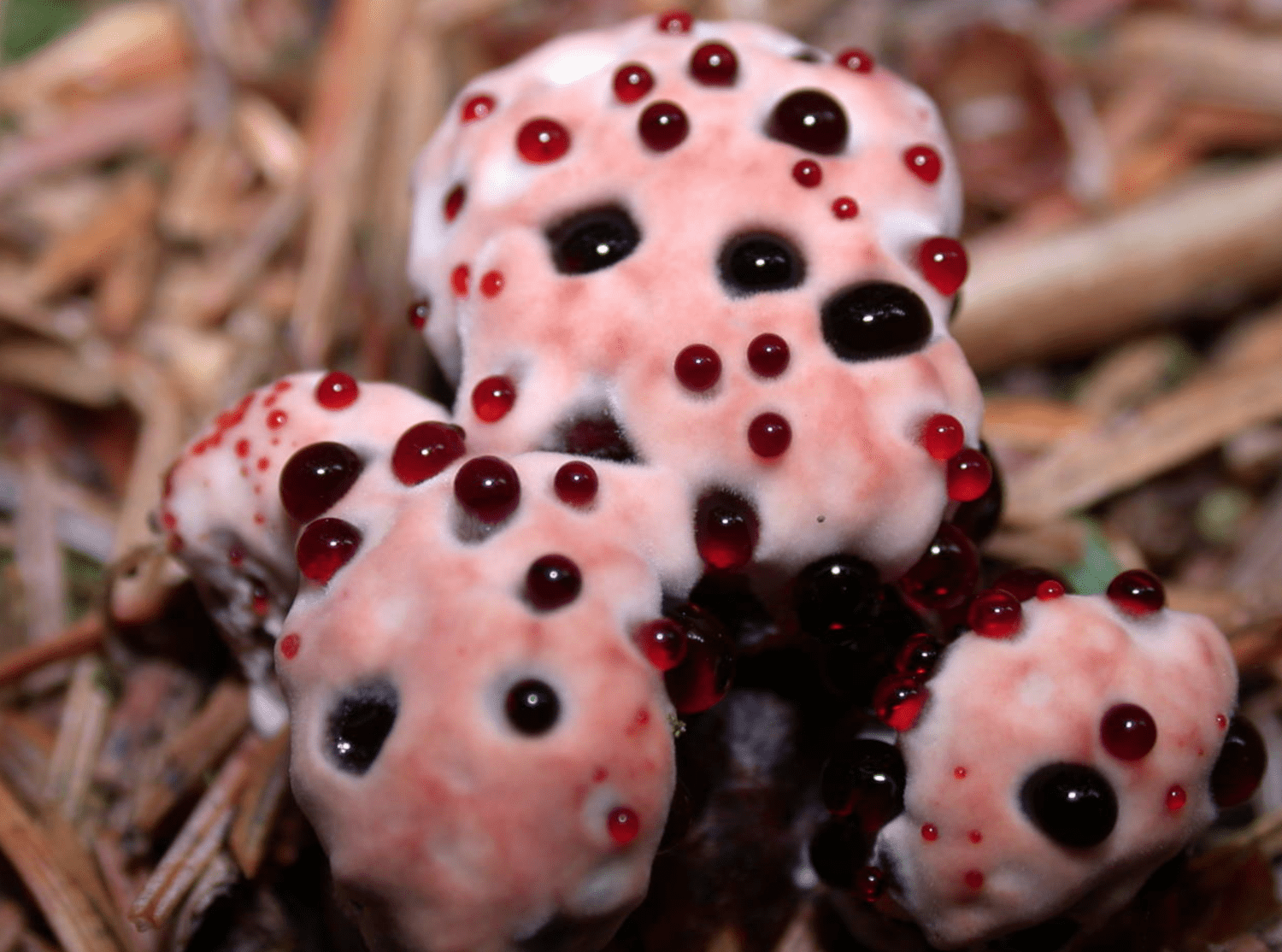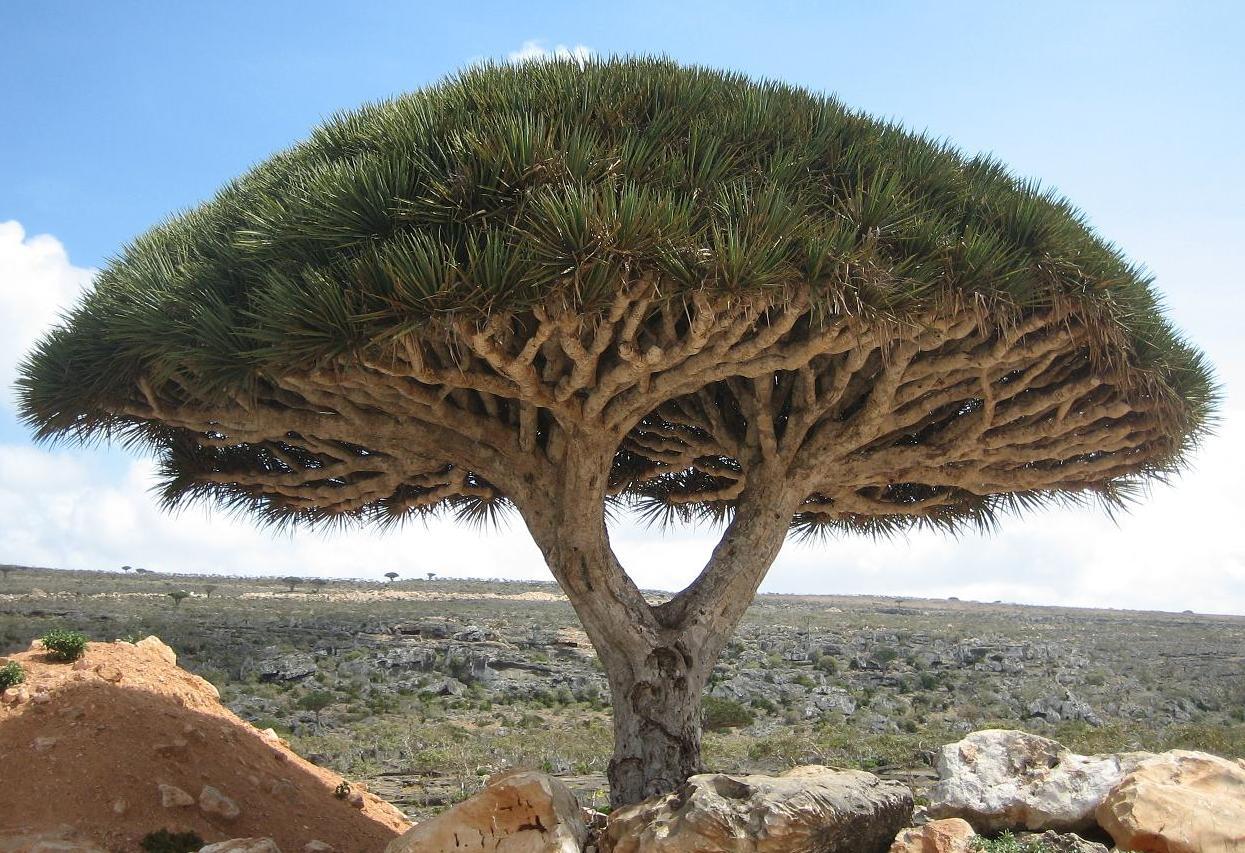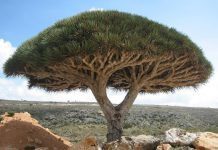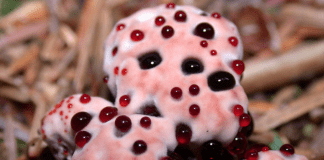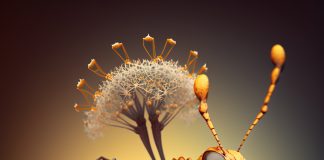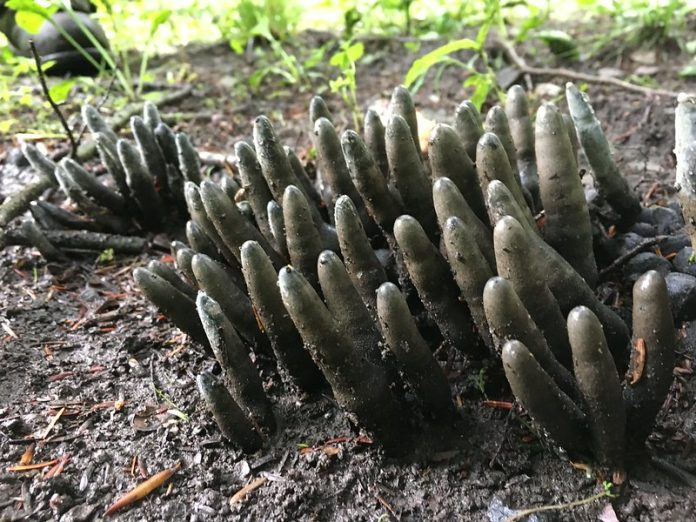
A Guide To The Fascinating World Of Dead Man’s Fingers Fungi
A dead man’s finger is a species of fungi with a long, finger-like appearance often found on dead trees. The finger’s dark brown color and spore formation, which is white or cream in appearance, gives it an unusual appearance. Despite its name, the dead man’s finger fungus isn’t poisonous, but it’s definitely unusual. Let’s delve into the interesting facts and medical uses of these fungi!
Classification
- The Dead Man’s Fingers fungi are a type of fungus.
- It is a member of the kingdom Fungi.
- Scientific Species Name: The scientific species name for the Dead Man’s Fingers fungi is Xylaria polymorph.
- Genus: The fungi belong to the genus Xylaria.
- Class: The fungi belong to the class Sordariomycetes.
- Family: The fungi belong to the family Xylariaceae.
- Order: The fungi belong to the order Xylariales.
- Subphylum: The fungi belong to the subphylum Pezizomycotina.
- Phylum: The fungi belong to the phylum Ascomycota.
What are Dead Man’s Fingers?
Dead man’s fingers, also known as dead man’s fingers fungi, is a fungal pathogen that grows in small groups of three to six mushrooms and resembles fingers coming out of the ground. The fungi are usually white when young and turn black over time, and the rot caused by it is usually soft and not cause for concern.
The dead man’s finger is an ascomycetous fungus that produces spores in sac-like cells called asci and goes through costume changes from spring to winter. The communal fruiting bodies are club-shaped and have greenish or bluish tinges when fully mature in fall and early winter.
This species of fungi are found in fields, spruce forests, conifer plantations, orchards, gardens, and around buildings. These mushrooms can be a common sight but should be avoided as they may have harmful effects on people’s health.
10 Interesting Facts About The Dead Man’s Fingers Fungi
- The Dead Man’s Fingers fungi get its name from its strange, finger-like shape that resembles human fingers.
- This fungus is found in parts of Europe and North America and typically grows on dead or decaying wood.
- The Dead Man’s Fingers fungi are not poisonous and are not known to be toxic to humans or animals.
- The fruiting bodies of the fungus can range in color from dark brown to nearly black color.
- The Dead Man’s Fingers fungi have been used in traditional medicine to treat various ailments, such as headaches, stomach problems, and infections.
- This fungus is an important decomposer in forest ecosystems, helping to break down dead wood and other organic matter.
- The Dead Man’s Fingers fungi are often confused with another fungus, Xylaria hypoxylon, which has a similar finger-like shape.
- The fruiting bodies of the fungus can range in size from just a few centimeters to over 20 centimeters in length.
- This fungus is capable of producing asexual spores, which are dispersed by wind and water.
- The Dead Man’s Fingers fungi have been the subject of scientific research due to their potential as a source of bioactive compounds with medicinal properties.
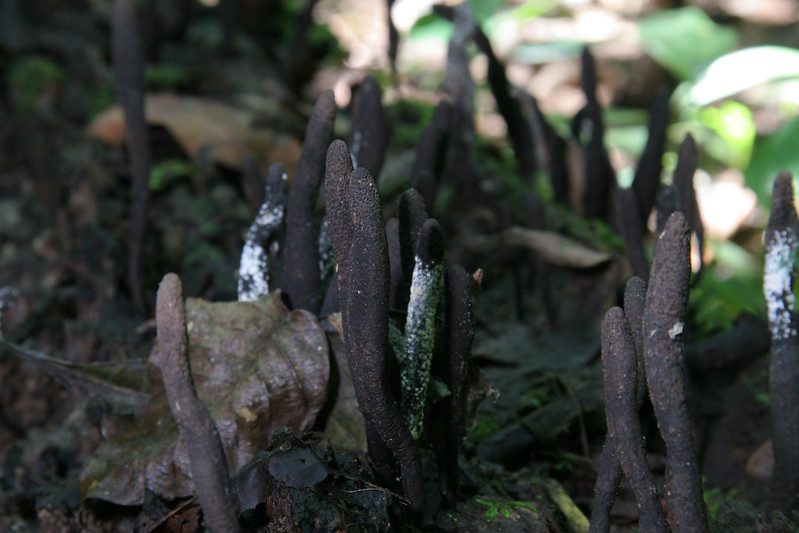
Description of Dead Man’s Fingers
Dead Man’s Fingers, scientifically known as Xylaria polymorpha, is a type of fungi that typically grows on decaying wood or fallen trees in parts of Europe and North America. It is called “Dead Man’s Fingers” due to its strange, finger-like shape, which resembles human fingers.
The fruiting bodies of the Dead Man’s Fingers fungus can range in size from just a few centimeters to over 20 centimeters in length and can vary in color from dark brown to nearly black color. In the spring, they are pale, coated with spore dust, with a whitish tip, while later in the season, they are dark brown and blackish, looking like something left by a cat. In the fall, they are dried out and black, and the surface is rough or minutely pimpled.
As the stroma mature, they can darken to dark brown and black, sometimes with greenish or bluish tinges. While dead man’s fingers are not harmful to trees, they can be unsightly and may cause some damage if left unchecked.
The best way to prevent a dead man’s finger from appearing on your tree is to keep your tree healthy, free of stress, and properly cared for. Additionally, a dead man’s finger can be removed by hand or using a sharp object.
Medicinal uses of the Dead Man’s Fingers
Dead man’s fingers are fungi that have medicinal uses. They are a type of saprophytic organism, meaning they only grow on dead or decaying wood. They’re a weak pathogen, meaning they don’t typically cause significant damage to trees.
The fungi are known for their ability to promote lactation after childbirth. A powdered form of a dead man’s fingers is mixed with sugar and used as a herbal remedy to induce lactation in women who cannot nurse their children naturally. The dead man’s finger species used in traditional medicine is Xylaria polymorpha. It is also known as the finger fungi.
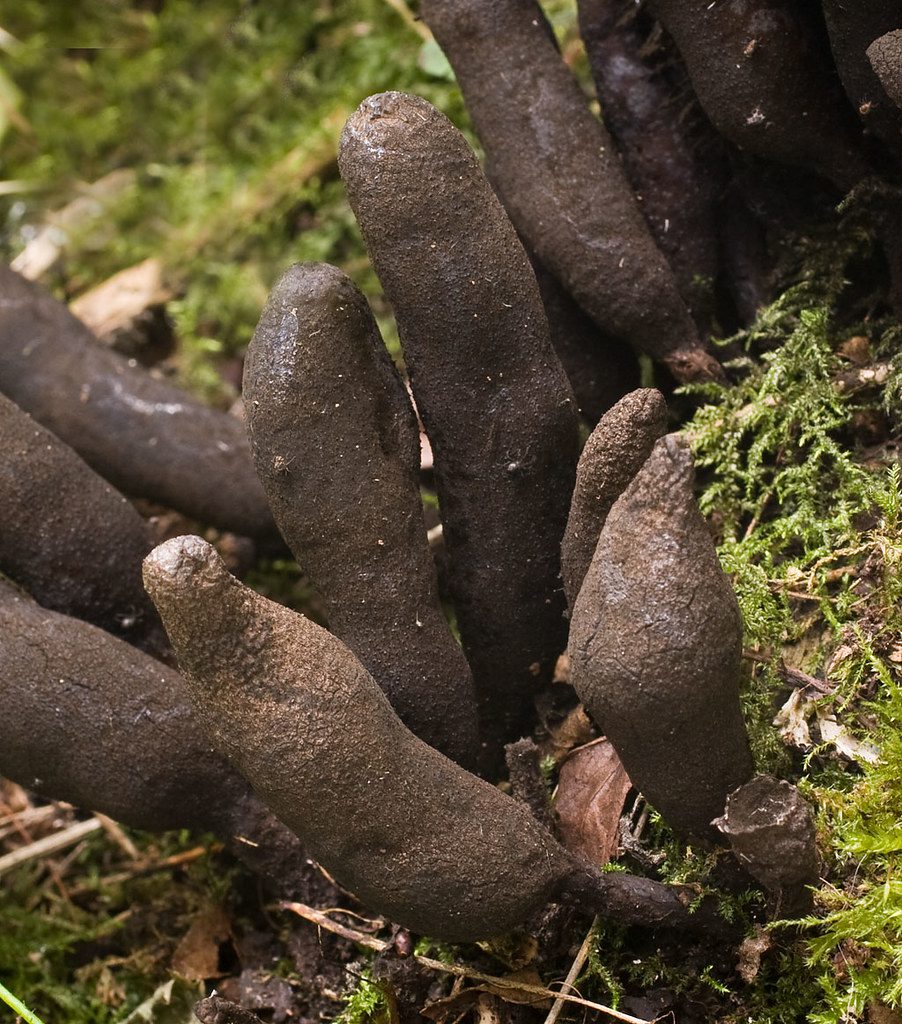
5 Medicinal Uses of the Dead Man’s Fingers
There is limited scientific research on the medicinal uses of the Dead Man’s Fingers fungi, and it is important to note that more research is needed to understand its potential benefits fully. However, here are five potential medicinal uses of the Dead Man’s Fingers:
- Antimicrobial Properties: The Dead Man’s Fingers fungi have been found to have antimicrobial properties and may be effective against a range of bacteria and fungi.
- Anti-Inflammatory Properties: Some studies suggest that the Dead Man’s Fingers fungi may have anti-inflammatory properties, which could make it useful in treating conditions such as arthritis and other inflammatory disorders.
- Antioxidant Properties: The Dead Man’s Fingers fungi contain compounds that act as antioxidants, which can help to protect cells from damage caused by free radicals.
- Immune-Boosting Properties: The Dead Man’s Fingers fungi may have immune-boosting properties, which could make it useful in supporting the immune system and fighting off infections.
- Pain Relief: Some traditional uses of the Dead Man’s Fingers fungi include the treatment of headaches and other types of pain. While more research is needed, some compounds found in the fungus may have pain-relieving properties.
How to identify Dead Man’s Fingers?
Dead man’s fingers are small fungi that grow in groups of three to six and have a white color when young, turning black over time. The fungi resemble fingers coming out of the ground and are 1-3cm in diameter and 3-8cm tall. Dead man’s fingers can be identified by their appearance, as they resemble fingers coming out of the ground.
If a dead man’s fingers are growing on the trunk or roots of a tree, it is a sign of infection. The tree should be removed immediately as dead man’s finger fungi can cause harm to the tree’s health. If dead man’s finger fungi are seen growing in hardwood mulch, removing the mulch can help solve the problem.
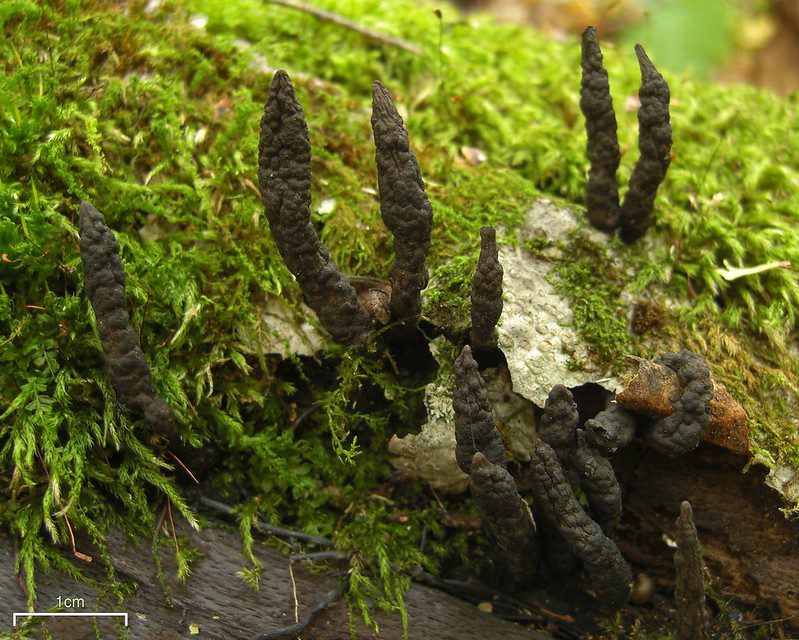
Habitat of Dead Man’s Fingers Fungi
Dead man’s fingers fungi are known as wood-loving fungi, and they typically grow on or near the stumps of dead wood, such as decaying beech, apple, maple, locust, and elm trees. These species can also invade stressed ornamental trees, such as ficus trees. The fungus Xylaria polymorpha is commonly found growing from the bases of dead tree stumps and decaying wood.
It is a saprotrophic fungus, which means it only grows on dead or dying wood and breaks down organic matter to be absorbed as nutrients by surrounding or future plants. Xylaria polymorpha is native to Europe and North America. It is a black spore-producing fungus that grows in deciduous forests during the fall and winter months.
When Were They First Discovered and By Who
Dead man’s fingers is an ascomycetous fungus, first discovered in the UK, Ireland, mainland Europe, and parts of North America.
It is unclear who first discovered Dead Man’s Fingers fungi, as it is a fairly common species that has likely been known to humans for many centuries. Fungi have been used for medicinal purposes and as a food source for thousands of years, and the use of Xylaria polymorpha may date back to ancient times.
However, the Swedish mycologist Elias Magnus Fries made the first scientific description of Dead Man’s Fingers fungi in the mid-19th century. Fries is considered one of the founding fathers of modern mycology and was instrumental in establishing the scientific classification of fungi. He described the fungus in his publication “Systema Mycologicum,” which was published in several volumes between 1821 and 1832.
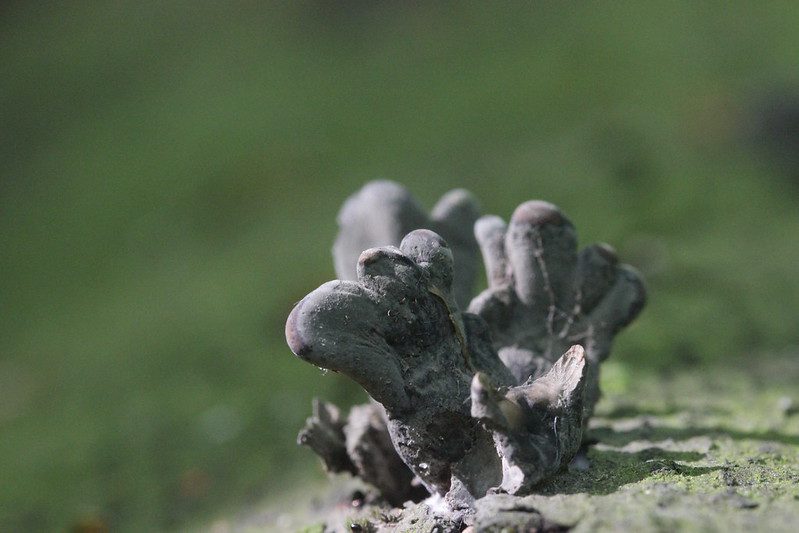
Stroma and perithecia
Dead man’s fingers fungi, Xylaria polymorpha, is a saprotrophic fungus that grows on dead or decaying wood. It’s characterized by fruiting bodies, which are club-shaped and grow in bunches resembling hands or fingers. The species’ stroma and perithecia have been documented in conservation and taxonomy descriptions. These spooky fungi are often mistaken for Halloween decorations due to their spooky appearance.
Some insects use the finger-like fruiting bodies of the fungi as a food source. These spore-producing organs also serve as a shelter for the fungus’s reproductive cells. However, the organisms’ diverse role as a natural resource makes them important parts of ecosystems that need protection.
Spores Of The Dead Man’s Fingers Fungus
The dead man’s fingers fungi is a white rot fungus species producing reproductive spores called conidia. The spore has a plano-conical shape and is made up of a hyaline, glistening mass of hyphae.
The spores are the primary means by which the fungus spreads and reproduces and are typically found growing from the bases of rotten tree stumps and decaying wood. The spores are released from the fingers and spread in the air as small particles.
The rot associated with dead man’s fingers fungi is a soft rot, and the spores are a weak pathogen that only attacks stressed trees.
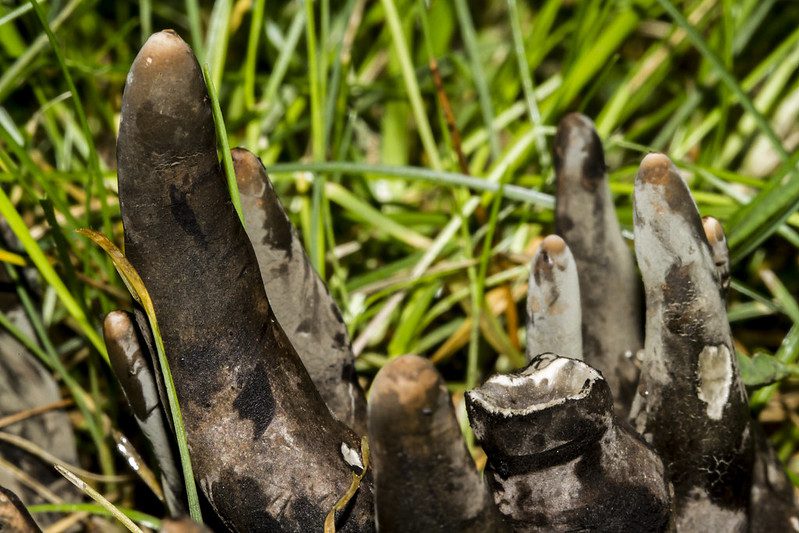
Odor/taste Of The Dead Man’s Fingers
They have white flesh inside. The taste of the fungus has been described as mild and pleasant. The aroma of the dead man’s finger has been compared to rotten wood or earth.
The dead man’s finger’s smell is not particularly strong. The odor of the fungus can be similar to mushrooms, socks, dead fish, or decaying vegetation. Sometimes, it’s described as a musty smell. The smell of the fungi can be pleasant or foul depending on the individual’s perception of it.
Ecological Role Of The Dead Man’s Fingers
The fungus, scientifically known as Xylaria polymorpha, plays an important ecological role in forest ecosystems. As a decomposer, it helps break down dead wood and other organic matter, releasing nutrients into the soil and making them available for other plants and organisms.
In addition to its role as a decomposer, the fungus may also help to control the populations of other fungi and bacteria in the soil. Some studies suggest that it produces secondary metabolites that can inhibit the growth of other microorganisms, which may help to prevent the spread of diseases and maintain a healthy soil ecosystem.
The fruiting bodies of the fungus are also a food source for various insects and other animals, including slugs, snails, and small mammals. The fungus may also play a role in supporting the growth of mycorrhizal fungi, which form symbiotic relationships with the roots of many plants and help to improve their nutrient uptake and overall health.
Overall, the Dead Man’s Fingers fungus is an important player in the complex web of life in forest ecosystems, contributing to the health and vitality of the forest community.
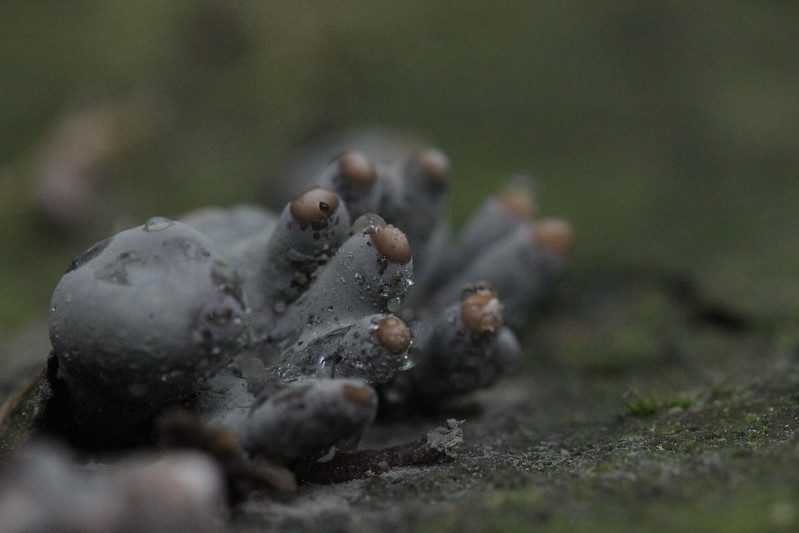
Growing Season Of The Dead Man’s Fingers
Dead man’s fingers are common ascomycetous fungi that emerge in the spring. After two to three weeks of growth, the fungus reaches its mature size and forms a finger-like structure.
The stroma, which consists of a spore mass and a finger-like appendage, grows throughout the summer and fully matures by late fall or early winter. After this, the fingers darken to a brownish or black color and become brittle and broken off from the main structure of the fungus.
The fruiting bodies of dead man’s fingers can be seen year-round but tend to be more abundant during warmer weather.
Conservation Of The Dead Man’s Fingers
The conservation of the Dead Man’s Fingers fungus, scientifically known as Xylaria polymorpha, is important in maintaining the health and diversity of forest ecosystems. However, there is currently no specific conservation status assigned to this species.
As a decomposer, the Dead Man’s Fingers fungus benefits from the conservation of forest habitats and the protection of dead wood and other organic matter. Practices such as sustainable forestry and the protection of old-growth forests can help ensure sufficient habitat for this species to thrive.
In addition to protecting forest habitats, it is also important to prevent the introduction of invasive species that could outcompete or otherwise harm the Dead Man’s Fingers fungus. This can be achieved through the use of best management practices and biosecurity measures, such as cleaning equipment and tools, before entering forested areas.
Finally, ongoing scientific research can help to improve our understanding of the ecology and potential uses of the Dead Man’s Fingers fungus, which may help to inform conservation efforts and ensure the long-term health and sustainability of forest ecosystems.
5 Similar Fungis Species
Here are five similar fungi species to Dead Man’s Fingers (Xylaria polymorpha):
- Xylaria hypoxylon – commonly known as the “Candle Snuff Fungus,” has a similar finger-like shape to Dead Man’s Fingers but is typically smaller and has a white, powdery surface.
- Hypoxylon fragiforme – also known as the “Beech Root Rot Fungus,” is a close relative of Xylaria polymorpha and shares similar ecological roles, including breaking down dead wood.
- Clavaria zollingeri – commonly called “Fingered Club Coral,” resembles Dead Man’s Fingers with its finger-like shape but is typically smaller and has a more delicate structure.
- Clathrus archeri – commonly called the “Octopus Stinkhorn,” is a bizarre-looking fungus that may resemble Dead Man’s Fingers in its dark, finger-like structures.
- Hericium erinaceus – commonly known as “Lion’s Mane Mushroom,” has a similar white, shaggy appearance to Dead Man’s Fingers but has a different branching structure and is edible.
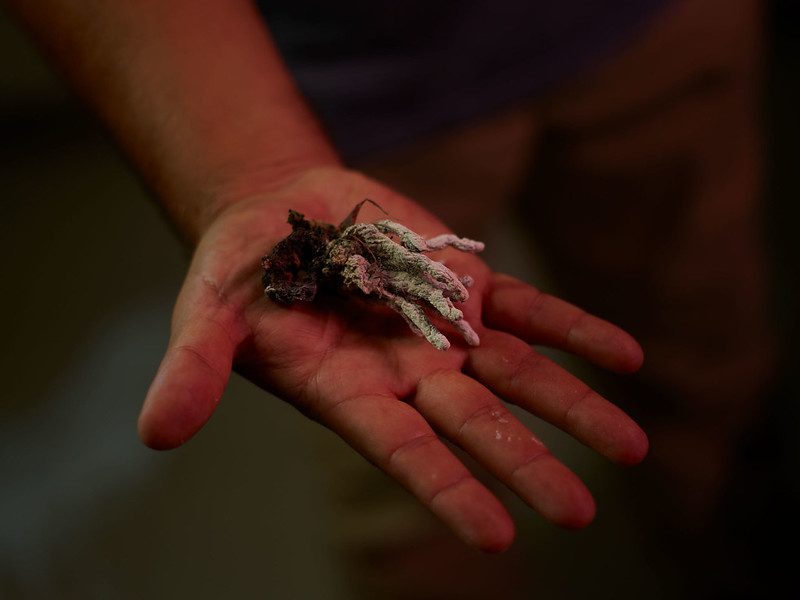
10 Interesting Facts about the Fungi
Fungi are a diverse group of organisms that play a vital role in the environment. They can be responsible for nutrient cycling, creating soil structure, and spore dispersal. Despite their important roles in ecosystems, few people are aware of the unique traits of these organisms. Here are ten interesting facts about fungi to whet your appetite.
- Fungi are one of the most abundant living organisms on Earth, making up approximately 24% of all species.
- Fungs form a significant part of the world’s food production as they aid in decomposing dead organic matter and can be used as a source of nutrient-rich composts and manures.
- In nature, fungi exist as single individuals or as part of aking or fruiting body (asexual and sexual reproduction).
- Fungi have an ecto-meso-endosymbiotic relationship with other organisms, such as plants and animals, through which they obtain nutrients and protect themselves from predators.
- Some fungi secrete enzymes during fruiting bodies that can be useful for biotechnology purposes. These enzymes include polygalacturonases which break down plant cell wall polymers, and xyloglucan endotransglucosylase, which breaks down xyloglucan polymers into sugar molecules.
- There are more than 20,000 species of fungi in the world, but only 1% have been identified so far.
- One fungal species called ‘Heterobasidion’ is capable of regenerating dead tissue after injury by producing new cells from its mycelium (rootlike network). This property has led to its use in the treatment of burns victims.
- Some fungi species are used in the manufacture of alcohols, cheeses, antibiotics, and as biocontrol agents against plant pathogens.
- Fungi can produce a variety of toxins that can be harmful to humans if ingested. These toxins include aflatoxins (produced by Aspergillus flavus), ochratoxins (produced by Penicillium verrucosum), and trichothecenes (produced by Stachybotrys atra).
- Fungi are believed to have first appeared on Earth more than 1.5 billion years ago.
Frequently Asked Questions
Are there any potential health risks associated with consuming Dead Man’s Fingers?
There is very limited information available on the potential health risks associated with consuming Dead Man’s Fingers (Xylaria polymorpha), and it is generally not considered a food source. It is important to note that some mushrooms and fungi can be poisonous. It is generally not recommended to consume wild mushrooms unless you are an experienced forager or have expert guidance.
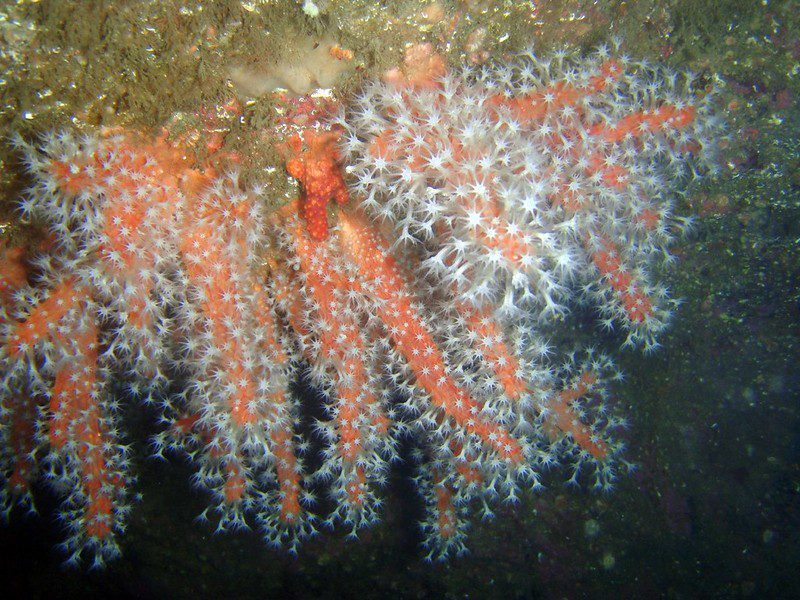
While there are no reports of toxicity associated with Dead Man’s Fingers specifically, it is possible that consuming this fungus could cause adverse effects in some individuals, particularly if consumed in large quantities. Some fungi contain compounds that can cause allergic reactions or gastrointestinal issues, and some may be toxic to the liver or kidneys.
If you are considering consuming any type of wild mushroom or fungus, it is important to exercise caution and consult a knowledgeable expert. Only consume mushrooms or fungi that have been positively identified by an expert, and avoid consuming mushrooms that are past their prime or show signs of decay or mold. Additionally, it is important to cook mushrooms thoroughly before consuming them to destroy any potential toxins or harmful compounds.
Are Dead Man’s Fingers fungus poisonous?
There seems to be some confusion between two different plant species that share the common name “Dead Man’s Fingers.” One plant species, Hemlock (Conium maculatum), is highly poisonous and has been colloquially known as Dead Man’s Fingers due to its finger-like appearance.
Hemlock is a member of the Umbellifer family, and all parts of the plant, including its tubers, stems, and leaves, contain a toxic compound called oenanthotoxin. Hemlock is considered one of the most poisonous plants in the UK and can cause death in a few hours after ingestion.
On the other hand, the Dead Man’s Fingers referred to in this article is a type of fungus scientifically known as Xylaria polymorpha. Unlike Hemlock, there is no evidence to suggest that this fungus is poisonous to humans or animals. While it is generally not recommended to consume wild mushrooms or fungi unless you are an experienced forager or have expert guidance, Dead Man’s Fingers is not known to be toxic or harmful if consumed in small quantities.
It is important to note the difference between Hemlock and the Dead Man’s Fingers fungus, as one is highly poisonous while the other is not. It is also important to exercise caution when foraging for wild plants and to seek expert guidance if you are uncertain about the safety of a particular species.
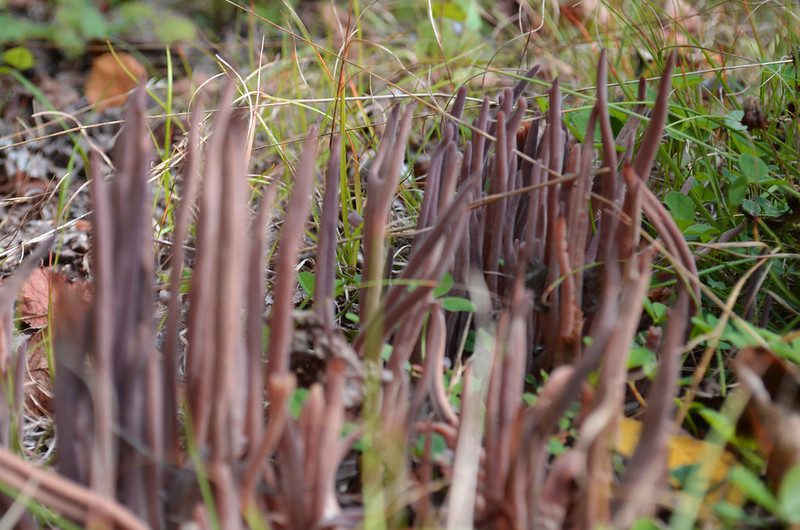
Are Dead Man’s Fingers rare?
There is no indication from a web search result that Dead Man’s Fingers (Xylaria polymorpha) are a rare species of fungus. In fact, some of the articles suggest that it is a common and widespread species. For example, one article from the Mirror states that the Xylaria Polymorpha fungus, commonly known as Dead Man’s Fingers, is common in the UK and Ireland.
However, it is important to note that the abundance and distribution of Dead Man’s Fingers may vary depending on the specific location and environmental conditions. Additionally, while this fungus may be common in certain areas, it is not a particularly notable or economically important species. It may not receive as much attention or study as other, more significant fungi.
Overall, while it is difficult to make a definitive statement about the abundance or rarity of Dead Man’s Fingers without more information, the available evidence suggests that it is a relatively common and widespread species of fungus.






































